Revenge is
Peep
March 4,
2006 AS XL
Unfamiliar with the SCA? Click here to take a quick light-hearted tour of this history-minded hobby. And now back to the matter at hand...
 There was a feast planned. And since it was lent, there had to be indulgences, yes? So Ariel, the headcook for the feast, arranged Lenten
indulgences through the intercession of St. Alan. Foolish me, I told Ariel I'd
do up the indulgences for her for the feast attendees. Then there was Estrella
and poor Duke Alan and that small matter of my pending revenge. And while I was
pondering the shape of my revenge, I remembered the feast and the indulgences
and then I knew...
There was a feast planned. And since it was lent, there had to be indulgences, yes? So Ariel, the headcook for the feast, arranged Lenten
indulgences through the intercession of St. Alan. Foolish me, I told Ariel I'd
do up the indulgences for her for the feast attendees. Then there was Estrella
and poor Duke Alan and that small matter of my pending revenge. And while I was
pondering the shape of my revenge, I remembered the feast and the indulgences
and then I knew...
 Having poured many wax seals onto many SCA awards, and having made my own candy, it occurred to me that one might possibly be able to melt peeps and use them like sealing wax. Thus began the great peep meltdown. Much smoke! Many gooey pots! Hundreds of melted peeps! But there was success and I managed to seal a dependent seal ribbon. I used a fork first to test the ability of the gooey brown mass to retain an impressed shape and then a coin to test detail. These were my early efforts and I did not think to record these first steps. After all, I had no idea that peeps would even work as sealing wax. What is a peep, after all, but a little sugar and a bunch of gelatin? It was possible, so I thought when I started, that it might not work - that the sugar content might be too low. I'm so glad that that wasn't the case.
Having poured many wax seals onto many SCA awards, and having made my own candy, it occurred to me that one might possibly be able to melt peeps and use them like sealing wax. Thus began the great peep meltdown. Much smoke! Many gooey pots! Hundreds of melted peeps! But there was success and I managed to seal a dependent seal ribbon. I used a fork first to test the ability of the gooey brown mass to retain an impressed shape and then a coin to test detail. These were my early efforts and I did not think to record these first steps. After all, I had no idea that peeps would even work as sealing wax. What is a peep, after all, but a little sugar and a bunch of gelatin? It was possible, so I thought when I started, that it might not work - that the sugar content might be too low. I'm so glad that that wasn't the case.
 Since I have received numerous emails expressing interest in the this project, I have built this page to show the mechanics of using peeps as sealing wax. The picture to the left shows the basic set-up that was the most successful. The tin alloy pot is usually used for making batches of medieval sealing wax. It has the virtue of retaining heat when removed from the heat source. This was crucial in the case of melted peeps because they lose their heat and start to goop-up almost instantly when removed from heat. A normal sauce pot did not cut the mustard with trying to pour melted peeps as a seal but the tin alloy pot kept them hot enough while pouring. After much experimentation, it turns out that good 'ol camp-stove potted-sterno fuel under a chafing-dish stand was the perfect heat source to keep the peeps perfectly melted and at the right temperature for pouring seals. The distance between the bottom of the pot and the top of the sterno can was 2.5 inches (slightly more than 6 cm). Not sure of how well the peeps would stick to paper, I went with a dependent seal scheme for the seals. I pre-sealed the seal ribbons with a little melted peep dribbled off the end of the spoon. Once the two ribbon ends were sandwiched in a thin dribble of peep (peep dribbles off spoon, paper ribbon ends as twirled in the dribble and then smashed together), they were set aside momentarily.
Since I have received numerous emails expressing interest in the this project, I have built this page to show the mechanics of using peeps as sealing wax. The picture to the left shows the basic set-up that was the most successful. The tin alloy pot is usually used for making batches of medieval sealing wax. It has the virtue of retaining heat when removed from the heat source. This was crucial in the case of melted peeps because they lose their heat and start to goop-up almost instantly when removed from heat. A normal sauce pot did not cut the mustard with trying to pour melted peeps as a seal but the tin alloy pot kept them hot enough while pouring. After much experimentation, it turns out that good 'ol camp-stove potted-sterno fuel under a chafing-dish stand was the perfect heat source to keep the peeps perfectly melted and at the right temperature for pouring seals. The distance between the bottom of the pot and the top of the sterno can was 2.5 inches (slightly more than 6 cm). Not sure of how well the peeps would stick to paper, I went with a dependent seal scheme for the seals. I pre-sealed the seal ribbons with a little melted peep dribbled off the end of the spoon. Once the two ribbon ends were sandwiched in a thin dribble of peep (peep dribbles off spoon, paper ribbon ends as twirled in the dribble and then smashed together), they were set aside momentarily.
 To make a seal, I would pour a seal-sized blob onto a pre-sealed ribbon, and my friend Master Robert the Lost would do the actually schmooshing of the seal onto the melted peep goo. The seal had to be iced between seals. Robert discovered that just a very thin coat of butter on the seal face helped in the detachment process. When everything went right, the seal would just pop off the cooling peep goo.
To make a seal, I would pour a seal-sized blob onto a pre-sealed ribbon, and my friend Master Robert the Lost would do the actually schmooshing of the seal onto the melted peep goo. The seal had to be iced between seals. Robert discovered that just a very thin coat of butter on the seal face helped in the detachment process. When everything went right, the seal would just pop off the cooling peep goo.
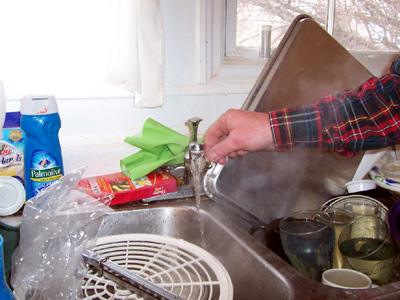 After the seal came up off the peep goo, Robert would wash the remains of the now-melted butter off the seal. Since I mentioned that the seal ring was small compared to big kingdom seals, this resulted in naming the seal ring a "baby seal." This set poor Robert off in giggling fits over the need to butter one's baby seals. Personally, I think it was the pain meds the man is taking for his recouping shoulder which very recently had surgery done on it.
After the seal came up off the peep goo, Robert would wash the remains of the now-melted butter off the seal. Since I mentioned that the seal ring was small compared to big kingdom seals, this resulted in naming the seal ring a "baby seal." This set poor Robert off in giggling fits over the need to butter one's baby seals. Personally, I think it was the pain meds the man is taking for his recouping shoulder which very recently had surgery done on it.
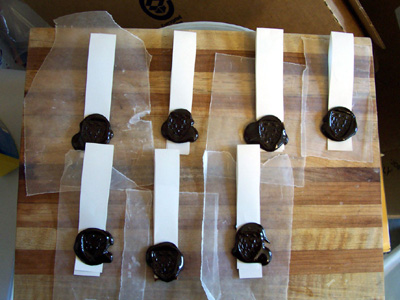 The seal we used was Duke Alan's seal. It appeared out of the thin air and dropped into my hand as Robert and I debated what we would use as a seal. Clearly this is yet another of the miracles of St. Alan. Mind you, since it was candle-light only at the feast, Duke Alan did not actually see that the seal impression was off his seal ring. He had no idea we sealed the indulgences with his personal seal. The Queen commanded me at the end of the feast to tell the tale of how the indulgences were made. Now I didn't see Alan's face as I was telling the populace in the feast hall about the how the seal miraculoutly appeared in my house on the previous Friday, but I'm told that the look on his face when he realized it was his seal on the indulgences was worth several times the price of admission to the event. Duke Alan since has opined that his darling, sweet and innocent wife, the most gracious Duchess Corisande must have slipped me his seal while he was off at work - but let me assure you all that this is patently false and he is mistaken about his blameless wife. It really did appear magically in my kitchen as Robert and I started to pour our seals. After all, both Robert and I saw it happen, truly!
The seal we used was Duke Alan's seal. It appeared out of the thin air and dropped into my hand as Robert and I debated what we would use as a seal. Clearly this is yet another of the miracles of St. Alan. Mind you, since it was candle-light only at the feast, Duke Alan did not actually see that the seal impression was off his seal ring. He had no idea we sealed the indulgences with his personal seal. The Queen commanded me at the end of the feast to tell the tale of how the indulgences were made. Now I didn't see Alan's face as I was telling the populace in the feast hall about the how the seal miraculoutly appeared in my house on the previous Friday, but I'm told that the look on his face when he realized it was his seal on the indulgences was worth several times the price of admission to the event. Duke Alan since has opined that his darling, sweet and innocent wife, the most gracious Duchess Corisande must have slipped me his seal while he was off at work - but let me assure you all that this is patently false and he is mistaken about his blameless wife. It really did appear magically in my kitchen as Robert and I started to pour our seals. After all, both Robert and I saw it happen, truly!
 Here's a not-so-great close up of the text on one of the indulgences. Of course, in the real middle ages, the indulgence would have been through the agency of someone licensed to sell indulgences by the church, ofttimes an almoner or medicant monk. Here in the SCA, the indulgence is through the intercession of St. Alan since that's part of this long-standing rather-involved Kingdom of Artemisia gag involving poor Duke Alan and way too many peeps. The text reads: "Know that through the intercession of St. Alan, the house and holder of this indulgence may partake of eggs and milk and meat this day eleven of lent - vat." Many legal documents in France and England ended in "vat" (short for vivat) or "amen" as a way to show where the document ended - a preventative step to keep people from adding something extra to the end of a legally-binding document.
Here's a not-so-great close up of the text on one of the indulgences. Of course, in the real middle ages, the indulgence would have been through the agency of someone licensed to sell indulgences by the church, ofttimes an almoner or medicant monk. Here in the SCA, the indulgence is through the intercession of St. Alan since that's part of this long-standing rather-involved Kingdom of Artemisia gag involving poor Duke Alan and way too many peeps. The text reads: "Know that through the intercession of St. Alan, the house and holder of this indulgence may partake of eggs and milk and meat this day eleven of lent - vat." Many legal documents in France and England ended in "vat" (short for vivat) or "amen" as a way to show where the document ended - a preventative step to keep people from adding something extra to the end of a legally-binding document.
 Here's a good shot of a whole indulgence with dependent seal. The seal is attached by a ribbon and threaded through the document at the fold at the bottom of the page. A second ribbon is threaded through the fold and acts as a support for the seal ribbon. [For those of you framing your indulgences - yes, there are a few - please remember to varnish your seals beforehand.] I only had 14 of the indulgences calligraphed before leaving for the feast on Saturday morning. I did the rest of the indulgences at the event. I got 32 done in time for the feast - which meant that we had enough indulgences for each household at the feast. I was cranking them out at about one indulgence every 10 minutes at the event. It wouldn't have been possible if I had been using a book hand instead of a secretary hand like my loopy bastarde hand. Duchess Corisande did all the ribbon threading for me to get the seals hung - for which I owe her my thanks since my figertips were sore and crisp from when I accidentally poured melted peep goo on them.>
Here's a good shot of a whole indulgence with dependent seal. The seal is attached by a ribbon and threaded through the document at the fold at the bottom of the page. A second ribbon is threaded through the fold and acts as a support for the seal ribbon. [For those of you framing your indulgences - yes, there are a few - please remember to varnish your seals beforehand.] I only had 14 of the indulgences calligraphed before leaving for the feast on Saturday morning. I did the rest of the indulgences at the event. I got 32 done in time for the feast - which meant that we had enough indulgences for each household at the feast. I was cranking them out at about one indulgence every 10 minutes at the event. It wouldn't have been possible if I had been using a book hand instead of a secretary hand like my loopy bastarde hand. Duchess Corisande did all the ribbon threading for me to get the seals hung - for which I owe her my thanks since my figertips were sore and crisp from when I accidentally poured melted peep goo on them.>
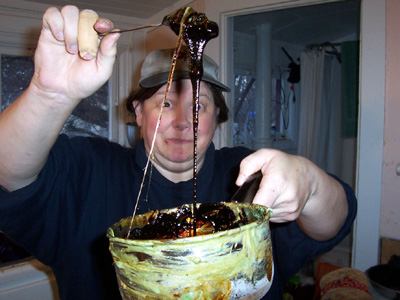 So Master Robert and I decided we wanted to do an additional batch of seals as we were sliding down toward the dinner hours on Friday. I had discovered that it's easiest to do the initial melting of the peeps in one pot and then to transfer the melted peeps to the tin alloy pot for pouring. So I put about 10 peeps in the pot on low heat and Robert and I went to put our feet up for a few minutes on the couch in the living room. We were really kinda tired at this point and started to talk about the feast the next day. And then, before I knew it, it was 40 minutes later and there was the smell of burning peeps filling the house (again). Robert had the camera in his hand as I investigated the last chapter of the Great Peep Project . . .
So Master Robert and I decided we wanted to do an additional batch of seals as we were sliding down toward the dinner hours on Friday. I had discovered that it's easiest to do the initial melting of the peeps in one pot and then to transfer the melted peeps to the tin alloy pot for pouring. So I put about 10 peeps in the pot on low heat and Robert and I went to put our feet up for a few minutes on the couch in the living room. We were really kinda tired at this point and started to talk about the feast the next day. And then, before I knew it, it was 40 minutes later and there was the smell of burning peeps filling the house (again). Robert had the camera in his hand as I investigated the last chapter of the Great Peep Project . . .
Click here to read the beginning of the Estrella War revenge thread on the Kingdom of Artemisia list. If you really want to know why I had to invent sealing medieval documents with peeps, this post describes the incident that motivated me to find a suitable revenge to inflict upon his Grace, Duke Alan - hence provided me with the opportunity to invent the methodology of using peeps as sealing wax. If you must, skip down to the second half of the post, directly to the part about fighting on Sunday at the War and read to the very bottom of the post for the tale of why there was a revenge.
Unfamiliar with the SCA? The Society for Creative Anachronism is an organization which investigates the culture of chivalry in the Middle Ages by holding armoured combat tournaments, creating Medieval feasts, making Medieval crafts and otherwise investigating Medieval and Renaissance culture through hands-on participation. It is the largest of all the Middle Ages living history groups, perhaps because the SCA focuses on more than just one small time slice of history. For more info on the SCA, click here, which takes you to the home page of the SCA Inc. To be honest, however, the description of the SCA that I like the best can be found on the site of commercial artist Randy Asplund, in his bio section, which can be found click here.)
Click here to go to my SCA Projects page.
Click here to go to my home page.
This page went on line atter midnight March 9, 2006. This page was last modified on November 27, 2006. No ads. No cookies. No marketroids. No Spam. No junk email. No hassle. I spell badly and sometimes links die. Send comments about this site to: no1home@onewest.net. Thanks for stopping by.
 There was a feast planned. And since it was lent, there had to be indulgences, yes? So Ariel, the headcook for the feast, arranged Lenten
indulgences through the intercession of St. Alan. Foolish me, I told Ariel I'd
do up the indulgences for her for the feast attendees. Then there was Estrella
and poor Duke Alan and that small matter of my pending revenge. And while I was
pondering the shape of my revenge, I remembered the feast and the indulgences
and then I knew...
There was a feast planned. And since it was lent, there had to be indulgences, yes? So Ariel, the headcook for the feast, arranged Lenten
indulgences through the intercession of St. Alan. Foolish me, I told Ariel I'd
do up the indulgences for her for the feast attendees. Then there was Estrella
and poor Duke Alan and that small matter of my pending revenge. And while I was
pondering the shape of my revenge, I remembered the feast and the indulgences
and then I knew...  Having poured many wax seals onto many SCA awards, and having made my own candy, it occurred to me that one might possibly be able to
Having poured many wax seals onto many SCA awards, and having made my own candy, it occurred to me that one might possibly be able to  Since I have received numerous emails expressing interest in the this project, I have built this page to show the mechanics of using peeps as sealing wax. The picture to the left shows the basic set-up that was the most successful. The tin alloy pot is usually used for making batches of medieval sealing wax. It has the virtue of retaining heat when removed from the heat source. This was crucial in the case of melted peeps because they lose their heat and start to goop-up almost instantly when removed from heat. A normal sauce pot did not cut the mustard with trying to pour melted peeps as a seal but the tin alloy pot kept them hot enough while pouring. After much experimentation, it turns out that good 'ol camp-stove potted-sterno fuel under a chafing-dish stand was the perfect heat source to keep the peeps perfectly melted and at the right temperature for pouring seals. The distance between the bottom of the pot and the top of the sterno can was 2.5 inches (slightly more than 6 cm). Not sure of how well the peeps would stick to paper, I went with a dependent seal scheme for the seals. I pre-sealed the seal ribbons with a little melted peep dribbled off the end of the spoon. Once the two ribbon ends were sandwiched in a thin dribble of peep (peep dribbles off spoon, paper ribbon ends as twirled in the dribble and then smashed together), they were set aside momentarily.
Since I have received numerous emails expressing interest in the this project, I have built this page to show the mechanics of using peeps as sealing wax. The picture to the left shows the basic set-up that was the most successful. The tin alloy pot is usually used for making batches of medieval sealing wax. It has the virtue of retaining heat when removed from the heat source. This was crucial in the case of melted peeps because they lose their heat and start to goop-up almost instantly when removed from heat. A normal sauce pot did not cut the mustard with trying to pour melted peeps as a seal but the tin alloy pot kept them hot enough while pouring. After much experimentation, it turns out that good 'ol camp-stove potted-sterno fuel under a chafing-dish stand was the perfect heat source to keep the peeps perfectly melted and at the right temperature for pouring seals. The distance between the bottom of the pot and the top of the sterno can was 2.5 inches (slightly more than 6 cm). Not sure of how well the peeps would stick to paper, I went with a dependent seal scheme for the seals. I pre-sealed the seal ribbons with a little melted peep dribbled off the end of the spoon. Once the two ribbon ends were sandwiched in a thin dribble of peep (peep dribbles off spoon, paper ribbon ends as twirled in the dribble and then smashed together), they were set aside momentarily. To make a seal, I would pour a seal-sized blob onto a pre-sealed ribbon, and my friend Master Robert the Lost would do the actually schmooshing of the seal onto the melted peep goo. The seal had to be iced between seals. Robert discovered that just a very thin coat of butter on the seal face helped in the detachment process. When everything went right, the seal would just pop off the cooling peep goo.
To make a seal, I would pour a seal-sized blob onto a pre-sealed ribbon, and my friend Master Robert the Lost would do the actually schmooshing of the seal onto the melted peep goo. The seal had to be iced between seals. Robert discovered that just a very thin coat of butter on the seal face helped in the detachment process. When everything went right, the seal would just pop off the cooling peep goo.
 After the seal came up off the peep goo, Robert would wash the remains of the now-melted butter off the seal. Since I mentioned that the seal ring was small compared to big kingdom seals, this resulted in naming the seal ring a "baby seal." This set poor Robert off in giggling fits over the need to butter one's baby seals. Personally, I think it was the pain meds the man is taking for his recouping shoulder which very recently had surgery done on it.
After the seal came up off the peep goo, Robert would wash the remains of the now-melted butter off the seal. Since I mentioned that the seal ring was small compared to big kingdom seals, this resulted in naming the seal ring a "baby seal." This set poor Robert off in giggling fits over the need to butter one's baby seals. Personally, I think it was the pain meds the man is taking for his recouping shoulder which very recently had surgery done on it. The seal we used was Duke Alan's seal. It appeared out of the thin air and dropped into my hand as Robert and I debated what we would use as a seal. Clearly this is yet another of the miracles of St. Alan. Mind you, since it was candle-light only at the feast, Duke Alan did not actually see that the seal impression was off his seal ring. He had no idea we sealed the indulgences with his personal seal. The Queen commanded me at the end of the feast to tell the tale of how the indulgences were made. Now I didn't see Alan's face as I was telling the populace in the feast hall about the how the seal miraculoutly appeared in my house on the previous Friday, but I'm told that the look on his face when he realized it was his seal on the indulgences was worth several times the price of admission to the event. Duke Alan since has opined that his darling, sweet and innocent wife, the most gracious Duchess Corisande must have slipped me his seal while he was off at work - but let me assure you all that this is patently false and he is mistaken about his blameless wife. It really did appear magically in my kitchen as Robert and I started to pour our seals. After all, both Robert and I saw it happen, truly!
The seal we used was Duke Alan's seal. It appeared out of the thin air and dropped into my hand as Robert and I debated what we would use as a seal. Clearly this is yet another of the miracles of St. Alan. Mind you, since it was candle-light only at the feast, Duke Alan did not actually see that the seal impression was off his seal ring. He had no idea we sealed the indulgences with his personal seal. The Queen commanded me at the end of the feast to tell the tale of how the indulgences were made. Now I didn't see Alan's face as I was telling the populace in the feast hall about the how the seal miraculoutly appeared in my house on the previous Friday, but I'm told that the look on his face when he realized it was his seal on the indulgences was worth several times the price of admission to the event. Duke Alan since has opined that his darling, sweet and innocent wife, the most gracious Duchess Corisande must have slipped me his seal while he was off at work - but let me assure you all that this is patently false and he is mistaken about his blameless wife. It really did appear magically in my kitchen as Robert and I started to pour our seals. After all, both Robert and I saw it happen, truly! Here's a not-so-great close up of the text on one of the indulgences. Of course, in the real middle ages, the indulgence would have been through the agency of someone licensed to sell indulgences by the church, ofttimes an almoner or medicant monk. Here in the SCA, the indulgence is through the intercession of St. Alan since that's part of this long-standing rather-involved Kingdom of Artemisia gag involving poor Duke Alan and way too many peeps. The text reads: "Know that through the intercession of St. Alan, the house and holder of this indulgence may partake of eggs and milk and meat this day eleven of lent - vat." Many legal documents in France and England ended in "vat" (short for vivat) or "amen" as a way to show where the document ended - a preventative step to keep people from adding something extra to the end of a legally-binding document.
Here's a not-so-great close up of the text on one of the indulgences. Of course, in the real middle ages, the indulgence would have been through the agency of someone licensed to sell indulgences by the church, ofttimes an almoner or medicant monk. Here in the SCA, the indulgence is through the intercession of St. Alan since that's part of this long-standing rather-involved Kingdom of Artemisia gag involving poor Duke Alan and way too many peeps. The text reads: "Know that through the intercession of St. Alan, the house and holder of this indulgence may partake of eggs and milk and meat this day eleven of lent - vat." Many legal documents in France and England ended in "vat" (short for vivat) or "amen" as a way to show where the document ended - a preventative step to keep people from adding something extra to the end of a legally-binding document.
 Here's a good shot of a whole indulgence with dependent seal. The seal is attached by a ribbon and threaded through the document at the fold at the bottom of the page. A second ribbon is threaded through the fold and acts as a support for the seal ribbon. [For those of you framing your indulgences - yes, there are a few - please remember to varnish your seals beforehand.] I only had 14 of the indulgences calligraphed before leaving for the feast on Saturday morning. I did the rest of the indulgences at the event. I got 32 done in time for the feast - which meant that we had enough indulgences for each household at the feast. I was cranking them out at about one indulgence every 10 minutes at the event. It wouldn't have been possible if I had been using a book hand instead of a secretary hand like my loopy bastarde hand. Duchess Corisande did all the ribbon threading for me to get the seals hung - for which I owe her my thanks since my figertips were sore and crisp from when I accidentally poured melted peep goo on them.>
Here's a good shot of a whole indulgence with dependent seal. The seal is attached by a ribbon and threaded through the document at the fold at the bottom of the page. A second ribbon is threaded through the fold and acts as a support for the seal ribbon. [For those of you framing your indulgences - yes, there are a few - please remember to varnish your seals beforehand.] I only had 14 of the indulgences calligraphed before leaving for the feast on Saturday morning. I did the rest of the indulgences at the event. I got 32 done in time for the feast - which meant that we had enough indulgences for each household at the feast. I was cranking them out at about one indulgence every 10 minutes at the event. It wouldn't have been possible if I had been using a book hand instead of a secretary hand like my loopy bastarde hand. Duchess Corisande did all the ribbon threading for me to get the seals hung - for which I owe her my thanks since my figertips were sore and crisp from when I accidentally poured melted peep goo on them.> So Master Robert and I decided we wanted to do an additional batch of seals as we were sliding down toward the dinner hours on Friday. I had discovered that it's easiest to do the initial melting of the peeps in one pot and then to transfer the melted peeps to the tin alloy pot for pouring. So I put about 10 peeps in the pot on low heat and Robert and I went to put our feet up for a few minutes on the couch in the living room. We were really kinda tired at this point and started to talk about the feast the next day. And then, before I knew it, it was 40 minutes later and there was the smell of burning peeps filling the house (again). Robert had the camera in his hand as I investigated the last chapter of the Great Peep Project . . .
So Master Robert and I decided we wanted to do an additional batch of seals as we were sliding down toward the dinner hours on Friday. I had discovered that it's easiest to do the initial melting of the peeps in one pot and then to transfer the melted peeps to the tin alloy pot for pouring. So I put about 10 peeps in the pot on low heat and Robert and I went to put our feet up for a few minutes on the couch in the living room. We were really kinda tired at this point and started to talk about the feast the next day. And then, before I knew it, it was 40 minutes later and there was the smell of burning peeps filling the house (again). Robert had the camera in his hand as I investigated the last chapter of the Great Peep Project . . .